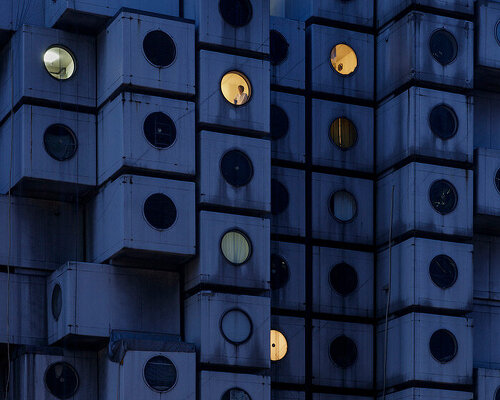an Architectural Time Capsule revisited in new york
The Nakagin Capsule Tower returns to public view this summer in a new light, as MoMA in New York opens an exhibition centered on its half-century lifespan. Built in Tokyo’s Ginza district in 1972 and dismantled in 2022, the structure was once among the clearest architectural expressions of Metabolism in Japan, a movement that sought to mirror natural growth and transformation in the built environment. Now, through a single, fully restored capsule and a constellation of archival materials, MoMA reactivates that legacy with the goal of inspiring inquiry over nostalgia.
Presented in the exhibition is capsule A1305, originally situated on the uppermost floor. For its display, it has been returned to near-original condition. Fragments of other salvaged units complete the restoration, from its modular furnishings to the audio controls and Sony color TV that defined its compact domesticity. Surrounding the capsule are more than 40 materials drawn from the tower’s five-decade history — models, promotional leaflets, film reels, and interviews that reveal how these micro-units adapted to lives far beyond their initial purpose. In a city shaped by constant renewal, this retrospective probes what it means to preserve an architectural concept. The Many Lives of the Nakagin Capsule Tower will be on view at MoMA from July 10th, 2025 until July 12th, 2026.
Kishō Kurokawa in front of the completed Nakagin Capsule Tower, 1974. image by Tomio Ohashi
kishō Kurokawa’s Unfolding Vision
MoMA is set to exhibit The Many Lives of the Nakagin Capsule Tower as an investigation into the iconic structure, which was originally imagined by architect Kishō Kurokawa as a machine for living that could regenerate itself. While the concrete towers were to remain as infrastructural anchors, the capsules were intended to be swapped out as needs evolved. That replacement never came. Yet the life of the tower defied stillness. The museum’s curatorial team, led by Evangelos Kotsioris and Paula Vilaplana de Miguel, foregrounds the tower’s informal transformations — capsules turned into galleries, DJ booths, or quiet spaces of solitude — offering a portrait of architecture shaped by use that transcends its intended programming.
By acquiring capsule A1305 in 2023, MoMA ensured a rare physical survival of a building long dismissed as unmaintainable. It is one of just fourteen capsules worldwide to have been carefully reassembled in original form. Visitors will be able to experience the unit in full during selected member activations, reinforcing the tower’s original intent as a space to be inhabited. The Nakagin Capsule Tower’s presence at MoMA sits within the museum’s wider ambition to question permanence, authorship, and the mutable nature of design.
Kisho Kurokawa, Architect & Associates (Tokyo, est. 1962). Nakagin Capsule Tower, Tokyo. 1970–72. exterior view. 1972. image by Tomio Ohashi
Extending the Conversation around nakagin capsule tower
MoMA’s exhibition The Many Lives of the Nakagin Capsule Tower will extend beyond the gallery. A companion book authored by Kotsioris for the MoMA One on One series explores the structure’s life cycle, from its speculative roots to its final days. With rarely published documents and firsthand accounts from the building’s last residents, the volume deepens the narrative around this experimental habitat. A suite of programs in partnership with Japan Society will also unfold throughout the exhibition’s yearlong run, framing the project within both its original context and its new American audience.
night time at the Nakagin Capsule Tower, with Mr. Takayuki Sekine seen through the window of capsule B1004, 2016. image © Jeremie Souteyrat
Kisho Kurokawa, Architect & Associates (Tokyo, est. 1962). Capsule A1305 from the Nakagin Capsule Tower. 1970–72; restored 2022–23. Steel, wood, paint, plastics, cloth, polyurethane, glass, ceramic, and electronics, 8′ 4 3/8″ × 8′ 10 5/16″ × 13′ 10 9/16″ (255 × 270 ×423 cm). The Museum of Modern Art, New York. Gift of Jo Carole and Ronald S. Lauder, Alice and Tom Tisch, and the Nakagin Capsule Tower Preservation and Restoration Project, Tokyo
Noritaka Minami. B1004 I, from the series 1972 (2010–22). 2011. archival pigment print, 20 × 25″ (101.6 × 127 cm) image © Noritaka Minami
images from Nakagin Capsule Style (Tokyo: Soshisha, 2020), showing Wakana Nitta (aka Cosplay Koe-chan) in her capsule, which she uses as a DJ-booth. courtesy Tatsuyuki Maeda / The Nakagin Capsule Tower Preservation and Restoration Project, Tokyo, Japan
Noritaka Minami. A503 I, from the series 1972 (2010–22). 2017. archival pigment print, 20 × 25″ (101.6 × 127 cm) image © Noritaka Minami
‘A twenty-first century home that thoroughly pursues functionality: Nakagin Capsule Manshon (Ginza),’ cover of promotional brochure for the Nakagin Company, 1971. image courtesy Tatsuyuki Maeda / The Nakagin Capsule Tower Preservation and Restoration Project, Tokyo, Japan
Kiyoshi Awazu. poster included with Kurokawa Kishō no sakuhin (Kisho Kurokawa’s work) (Tokyo: Bijutsu shuppan-sha, 1970). 1970. screenprint, 40 3/16 × 28 9/16″ (102 × 72.5 cm). image © Kiyoshi Awazu
project info:
name: The Many Lives of the Nakagin Capsule Tower
museum: Museum of Modern Art (MoMA) | @themuseumofmodernart
on view: July 10th, 2025 — July 12th, 2026
The post MoMA to explore the legacy of the iconic nakagin capsule tower in upcoming exhibition appeared first on designboom | architecture & design magazine.

